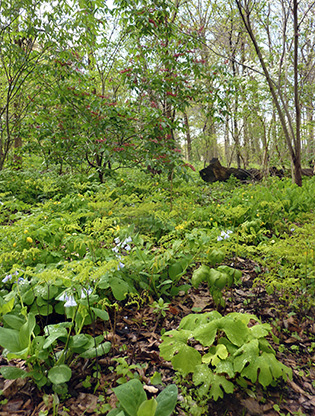
 If your site is currently wooded, restoring a mix of healthy woodland vegetation is an effective rainwater management strategy.
If your site is currently wooded, restoring a mix of healthy woodland vegetation is an effective rainwater management strategy.
Removal of invasive plant species (for example, bush honeysuckle) and long term control of all invasive species is essential in the successful restoration of woodland. Invasive species destroy the native ecosystem and out-compete native plants for nutrients, light and moisture. If these species are not controlled, they will continue to spread rapidly and diminish biodiversity as they overtake the woodland.
Following removal of invasive species, replant with mix of native plant species that is appropriate for your particular woodland (dry, upland woodland versus more moist, low woodland).
For more detailed woodland restoration recommendations and native plant lists see Work Wonders with Woodlands.
Click on a landscaping option from the graphic below to learn more about that topic: